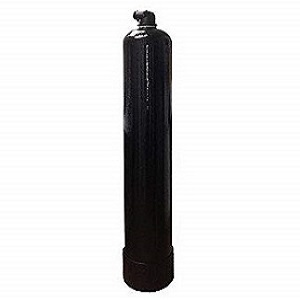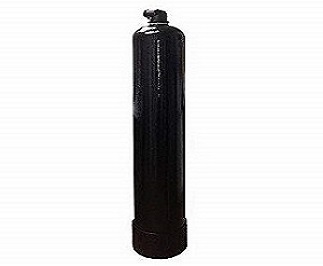

pH neutralizing filters are devices that are raised to increase the pH value of drinking water to around 7. This helps reduce plumbing or corrosion problems in pipes, which deliver drinking water.
Neutralizing filters have a sacrificial media inside a vessel. Common trade names of these media are Calcite, Flomag and Corosex. Calcite media is essentially limestone (calcium carbonate) and is ideal for water have a pH below 7 and above 6.4. The latter two are magnesium carbonate and are used for water that have a lower pH as they dissolve much faster. As the media dissolves, it will neutralize the excess hydrogen and increase the pH by adding carbonate. It will also increase the hardness which at times is beneficial. These pH neutralizer filters can also be used to “re-mineralize” and improve the taste of water after being treated with reverse osmosis systems.
A basic pH neutralizer system features a vessel (polypropylene tank reinforced with an outer layer of fiberglass) and a filter head. These can either have an inlet/outlet head or a back washable valve head. Inside the vessel, there is a riser tube connected to the head and extends to the bottom of the vessel with a bottom distributor (screen). The media will be a calcium carbonate mineral or a magnesium carbonate mineral.
For slow moving water, it is advisable to use a back washable valve to lift the media and prevent the media from caking. Caking is a term used when the media fuses together and creates channels, reducing water’s contact time, and creates pressure loss. If an in/out head is used, it is recommended to use a reverse flow so the water come through the riser tube to lift the media and reduce the potential for caking. For larger volumes of water being treated in commercial or industrial applications, soda ash is generally used via a chemical feed system.
Other technologies can be used to lower pH if the alkalinity is having issues on appliances/equipment or makes bathing uncomfortable. The following are a few important pH adjustment systems used today.
Carbon dioxide injection systems and anion exchange resins are generally not used to treat high pH or alkalinity; however, the reduction of alkalinity and pH is a byproduct of the process. You can approach us today to know more about the effectiveness of different pH neutralizers and their importance in your project. We are committed to help you resolve your pH issues or other water quality issues by providing you the best quality products like pH neutralizers at unbeatable prices.

What is pH? pH is a measurement of the hydrogen ions (acid) present in a solution (water). The pH scale is a logarithmic scale (ranging from 0-14) used to determine that hydrogen concentration. At a neutral pH of 7.0, there is an equal amount of hydrogen H+, as there is of hydroxyl radicals (OH-). What is Acid/Acidic Water? A water analysis with a number below 7 is considered acidic water (aggressive) and any number above 7 is considered basic water (alkaline water). A pH of 5, for example, results in ten times more acidic water than 6 and 100 times more acidic water than 7. The opposite is true for numbers above 7, which can represent the lack of hydrogen in the form hydroxyl radicals. The greater the number on the pH scale represents the increased number of hydroxyl radicals present and the more alkaline the water becomes. Why is Acid Water Bad? Acid water (low pH) can dissolve copper plumbing, pit fixtures, damage valves, and attack appliances such as dish washers, hot water heaters, and washing machines. Acid water also can impart a bitter taste. How to Raise a Water’s pH? The most effective, least costly, and the method that requires the least maintenance to treat Acid water is utilizing an acid neutralizing filter. Acid filters use a sacrificial media that slow dissolves and increases the water’s pH. Acid neutralizing filters for well water are very common as rain combines with carbon dioxide to form carbonic acid as the water works its way down to the aquifer. How to Treat Acidic Water with Different Methods? In the past, a solution of baking soda (sodium bicarbonate or soda ash (sodium carbonate) was injected into the water. This method requires a chemical holding tank, stirring system, and an...